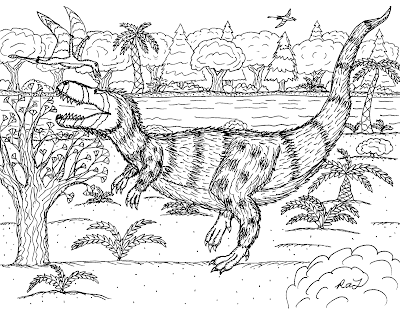The printable version of these drawings are found by clicking the "All Printables" or "Religios" buttons above. You will find new drawings listed at the bottom of the list in All Printables. There is an Old Testament section of the "Religios" page where you will find the David and Goliath drawings.
The story of David and Goliath in in 1 Samuel chapter 17. . . in the
Holy Bible.
David was a brave shepherd. He went to the Israelite Army camp to bring food to his brothers who were in the army. The giant Goliath (about 9 feet or almost 3 meters tall) was challenging King Saul to provide a champion to fight. In that day sometimes battles were decided by two champions facing off against each other. The winner of the one on one fight would win the battle for his whole army.
Goliath had been challenging the Israelites and their king for some time. (40 days) None of the soldiers in the Israelite army wanted dared fight a giant. When David heard Goliath challenging the king and the Israelite Army David was appalled. He felt like Goliath was defying the army of the Living God. So to David it was a religious thing.
David volunteered to fight Goliath. His older brothers thought he was just being naughty. . .thinking that he just wanted to see the battle. When Saul met David he thought David was being unrealistic about his chances against Goliath. But David told of how he had killed both a lion and a bear to defend his father's sheep.
King Saul tried to give his armor to David to use. But David said that he was not proved using that armor. In other words, David was not used to fighting in this armor and he needed to fight using weapons etc. that he already was familiar with.
David bravely went to face Goliath. In today's drawing we see David actually turning his back to Goliath to pick up some small smooth stones to use as ammunition for his sling. Goliath can be seen a ways away mocking David. Little did Goliath know that he was about to meet his doom.
David vs Goliath Before the Fight
(This is a new drawing.)
David had faith that he would have God's help to kill the giant. In my opinion David was one of the bravest boys in all known history. David also had skills with the sling. He HAD prepared himself but he also had great faith. This is a good lesson for all of us.
"Do all we can, like it all depended upon us and pray like it all depended on God." Brigham Young said that.
David vs Goliath
Of course in the end David was successful. David either killed or at least knocked out Goliath with a stone from his sling. Think about it...a tiny smooth stone brought down a giant. With Goliath lying there David took Goliath's sword and finished him off. The Philistines fled in terror at the loss of their champion. The Army of Israel won the battle and the war!
NOTE: These drawings are independent. Sorry that the characters do not match. The new drawing of David and Goliath Before the Battle has a more accurate helmet for Goliath. In the new drawing you see that Goliath had a "shield bearer."
SECOND NOTE: Got the sword added. It was not in the first version of the new drawing.



















































